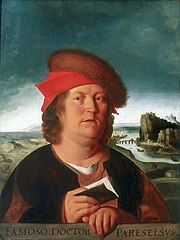Paracelsus
Paracelsus (11 November or 17 December 1493 in Einsiedeln, Switzerland – 24 September 1541 in Salzburg, Austria) was a Swiss-Austrian alchemist, physician, astrologer, and general occultist. The name "Paracelsus" was a nickname: it means "equal to or greater than Celsus", and refers to his medical skill.[1] He was born Phillip von Hohenheim.[2]

He gained his doctorate degree from the University of Ferrara in 1515 or 1516.[3][4]
He gave zinc its name (in Latin as "zincum").[5] He also named the cyanobacterium Nostoc, which is a long-chain colonial bacterium. The adjective "bombastic" comes from his family name. It refers to his arrogance.
Paracelsus was responsible for the creation of laudanum, an alcoholic herbal opium preparation. It was in common use up to the 19th century. Like most of the alchemists, he was a notable botanist.[6] He wrote various books, but especially his major work (title translated as: On the miners' sickness and other diseases of miners). This listed the occupational hazards of metalworking, including treatment and prevention strategies. He also wrote a book on the human body which contradicted Galen's ideas. He disagreed with Galen's idea of four humours, and instead believed that disease could come from an external source.
Works change
During his lifetime change
- Die große Wundarzney, 1536.
- Vom Holz Guaico, 1529.
- Vonn dem Bad Pfeffers in Oberschwytz gelegen, 1535.
- Prognostications, 1536.
Selected translations change
- The Hermetic and Alchemical writings of Paracelsus. (translated by Arthur Edward Waite) 2 vols, London, 1894. (in Google books), see also a revised 2002 edition (preview only) Partial contents: Coelum philosophorum; The book concerning the tincture of the philosophers; The treasure of treasures for alchemists; The aurora of the philosophers; alchemical catechism.
- The Archidoxes of Magic by Theophrastus Paracelsus, translated by Robert Turner. Facsimile reprint of the 1656 edition with introduction by Stephen Skinner, Ibis Publishing, 2004.
References change
- ↑ Read J. 1961. Through alchemy to chemistry. London: Bell.
- ↑ A longer version is Philippus Aureolus Theophrastus Bombastus von Hohenheim. It seems unclear which version was the original name given at his christening.
- ↑ Schaber, Johannes 1993. Bautz, Traugott. ed (in German). Paracelsus, lat. Pseudonym von {Philippus Aureolus} Theophrastus Bombastus von Hohenheim. Biographisch-Bibliographisches Kirchenlexikon (BBKL). 6. Herzberg. cols. 1502–1528. ISBN 3-88309-044-1.
- ↑ Marshall James L; Marshall Virginia R (2005). "Rediscovery of the elements: Paracelsus" (PDF). The Hexagon of Alpha Chi Sigma (Winter): 71–8. ISSN 0164-6109. OCLC 4478114. Archived from the original (PDF) on 2006-09-28. Retrieved 2012-07-31.
- ↑ Habashi, Fathi, Discovering the 8th Metal (PDF), International Zinc Association (IZA), archived from the original (PDF) on 2008-12-09, retrieved 2008-07-25.
- ↑ Hefner Alan G. "Paracelsus".